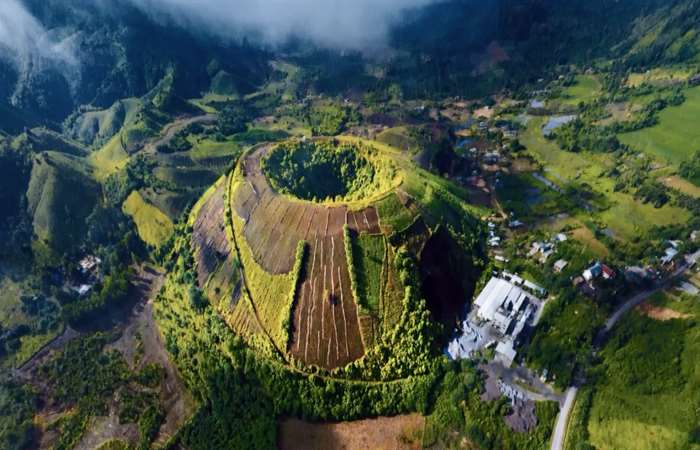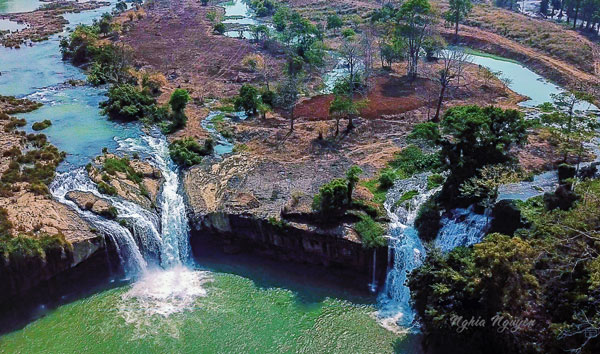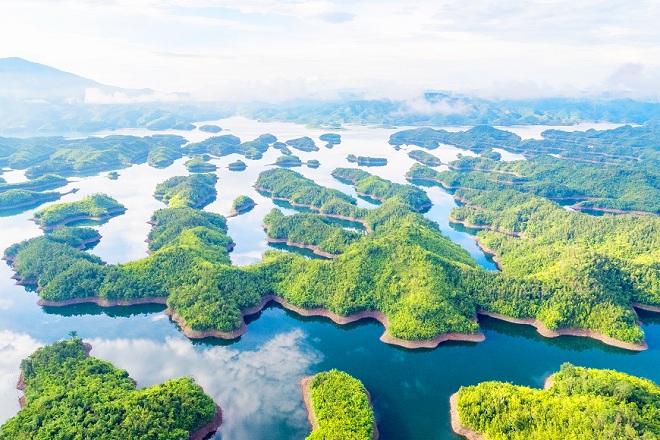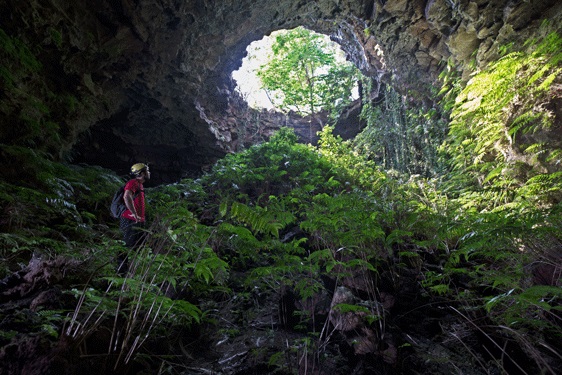(TITC) - Dak Nong Geopark established in December 2015 stretches over an area of 4,760 square kilometers, including districts of Krong No, Cu Jut, Dak Mil, Dak Song, Dak G'long and Gia Nghia City belonging to Dak Nong Province in the Central Highlands of Viet Nam. With typical values of geology, geomorphology, archeology, culture and biodiversity, Dak Nong Geopark was recognized by UNESCO as a Global Geopark in July 2020, which promises to become a highlight to attract domestical and international visitors coming to the Central Highlands Region and also Dak Nong Province.

Overview of Dak Nong Geopark. Photo: Internet
Dak Nong Geopark is a complex of natural terrain including volcanic cave systems, tropical forests, mountains, rivers, lakes, valleys, and delta, which have both geological and historical meanings. The geopark has about 65 geological and geomorphologic heritage sites, with nearly 50 caves with a total length of more than 10,000m, 5 craters, many beautiful lakes and waterfalls... Moreover, there are abundant diverse flora and fauna, many rare minerals formed after tectonic activities from millions to hundreds of thousands of years ago and traces of prehistoric humans.
The history of this land goes back 140 million years ago, when it was part of a vast ocean with traces found such as sedimentary rocks, ammonoidea fossils and other fossils. Tectonic movement of the Earth's crust had caused this area to be raised and volcanic appearance. It was volcanic eruptions that covered half of the area with layers of basaltic lava.
When spending a visit to this geopark, tourists have a chance to discover majestic natural landscapes in the Central Highlands, experience the interesting activities and immerse themselves in the mesmerizing sounds of nature and humans there.
Geomorphological and geological values

Dray Sap Waterfall. Photo: internet
The most special feature in Dak Nong Geopark is the basalt cave system located in Dray Sap-Chu R'Luh area and discovered in 2007. This volcanic cave system has been recognized by Japan Caving Association with the record of Southeast Asia for its size, length and uniqueness. The caves still keep many secrets about the formation mechanism, mineral combinations, biodiversity and archaeological sites, etc.
In the Geopark, there are geological heritage properties such as the fossils of ammonoidea, scallops, and pieces of shell... to prove that this period was still a part of the vast ocean.
In addition, there are 5 unique and characteristic craters including Nam Blang, Nam Kar, Bang Mo, Nam Dong, Nam Gle (or Thuan An), poetic natural lakes such as Ea Sno Lake, West Lake established from tectonic sinks, and system of beautiful and majestic waterfalls like Gia Long, Trinh Nu, Dray Sap, etc.
In addition, Dak Nong Geopark also preserves diversified and abundant mines and ore sites of bauxite, antimony, sandstone, puzolan, precious stones and especially large-sized opal-chalcedony semi-precious stones.
Archaeological values
The archaeological discoveries of prehistoric human living in the volcanic cave area of Geopark have attracted the attention of many domestic and foreign researchers and visitors.
Initial research results, along with the collection of highly dense archaeological relics showed that was cultural traces of human in the Late Neolithic and Early Metal Age (6,000-3,000 years ago). The archaeological relics include stone, raw stone and disc-shaped stone tools, short ax, flake tool, slab, grinding piece, etc.
About ceramics, there are many types of objects, with different thicknesses, made from sandy clay. Patterns on the pieces of pottery are quite sharp and diverse. Besides, there are animal bones, and also prehistoric human bones.
Biodiversity values
Nam Nung Nature Reserve, Ta Dung National Park, special-use forest of Dray Sap and a southern part of Yok Don National Park (Ea Po Commune, Cu Jut District) are places saving characteristics values of biodiversity in the area of Dak Nong Geopark.

Ta Dung Lake. Photo: internet
The flora and fauna system in the Geopark is very rich with many rare varieties and species listed in the Red Book of Viet Nam and the world, in which animals such as elephants, tigers, bisons and many primates (white-cheeked langurs, black-shanked doucs, reptiles, Hong Hoang (Buceros bicornis) birds, polyplectron germaini birds)…; and plants include trigonobalanus verticillata oak, Cephalotaxus mannii (Dinh Tung), Hopea odorata (Sao), Dalbergia cochinchinensis (Trac), Pterocarpus macrocarpus (Giang Huong), Xylia xylocarpa (Cam xe) ... This is a great potential for Geopark to develop models of ecotourism, exploration and research on biodiversity to attract scientists as well as domestic and foreign tourists.
Historical and Cultural values

Photo: internet
Dak Nong was originally inhabited by three indigenous peoples, the M’Nong, Ma and Ede. Following an influx of immigrants in the late 1970s, it has become the home of over 40 ethnic groups with rich cultural diversity. This land preserves the tangible and intangible cultural values such as Central Highlands Gong Culture Space, The Epic of Ot N'drong. Coming there, visitors have opportunity to enjoy local gongs performances, interest traditional musical instruments, visit sound exhibition, and learn brocade weaving and traditional knitting.
Besides, Dak Nong Geopark owns a special national-level relic of Ho Chi Minh Trail and 5 other national-level relic sites such as Dak Mil Prison, B4 Resistance Base - Interprovincial IV, N'Trang Gưh historic and memorial site, Victory Site of Hill 722-Dak Sak, Location for contacting and clearing Ho Chi Minh road from the South Central Highlands to the Southeast. The above values also make Dak Nong Global Geopark being a place worth exploring.
Preserve and promote the value of heritages for tourism development
Dak Nong Geopark is a complex model helping visitors learn about the formation of the earth through the form of geological tourism. This model promotes the education and awareness increase for people and visitors to live in harmony with nature, to respect the natural values and resources.

C7 cave is more than 1 km long, the diameter of the cave entrance is about 20 m, surrounded by a steep cliff. Photo: Takeshi Murase
At present, there are 5 volcanoes in Dak Nong Geopark, including Nam Dong, Bang Mo (Cu Jut District), Nam Blang, Nam Kar (Krong No District) and Nam Gle (Dak Mil District). Among the caves, the highlight is C7 cave with a length of 1,067m, identified as the longest lava cave in Southeast Asia. Next are C6.1 cave longer than 968 meters and C3 cave (also known as Bat cave) with 594 meters long.
Coming to Dak Nong Geopark, visitors will admire the unique and pristine basal volcanic cave system which has set the longest record in Southeast Asia (starting from Krong No District); contemplate the pristine and majestic landscapes such as Bang Mo volcano (Cu Jut District), Nam Gle R'luh volcano (Dak Mil District); explore Ta Dung National Park with scenic Ta Dung Lake, which is known as Ha Long Bay on the plateau, join the journeys to the villages of Ede, M'Nong groups with many unique indigenous cultural features.
Once recognized as a Global Geopark, Dak Nong Province has developed a propaganda plan for people to understand the precious values, conserve and develop together. The province's point of view is to build a model of community-based tourism. People will play the important role for preserving the values. That is the property of the people themselves. Local tourism must be developed from that basement.
On the basis of geopark, Dak Nong Province has planned and invested 44 attractive destinations for tourism development. The destinations are built according to 3 main themes: "The anthem of fire and water"; "Symphony of new wind" and "Resonance from the Earth" to best mobilize the combined values of tourism products with the geological and cultural heritage values.
Dak Nong Province is calling organizations and businesses to participate in tourism and service development to perfect tourism products in the area of Dak Nong Geopark towards sustainability.
TITC